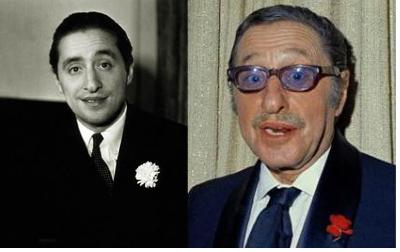
Harold Arlen
by Alix Cohen
Live Streamed under the aegis of the 92Y which continues its diverse programs online https://www.92y.org/
Today’s event opens with a black and white television clip of young Frank Sinatra singing a no-fuss “One For My Baby (and one more for the road.)” The bluesy 1942 song was written by Harold Arlen and Johnny Mercer for The Sky’s the Limit. Host Louis Rosen is approaching Arlen’s considerable oeuvre through the writer’s own idiosyncratic performance and his three most important collaborators, Ted Koehler, E.Y. “Yip” Harburg, and Johnny Mercer.
Hyman Arluck aka Harold Arlen 1905 –1986 was born in a predominantly black neighborhood in Buffalo, New York, son of a cantor. Early music influence came from both the synagogue and sounds he heard around him. Arlen started piano at 9, but wasn’t enthusiastic until he discovered ragtime and early jazz. He excitedly played a Louis Armstrong recording for his father only to be told, “I was doing riffs like that before you were born.” The cantor was a fan of Louisville jazz.
The young musician/singer/arranger joined a succession of bands. We watch a clip of a documentary to get a sense of the adult man, then one in which he’s performing as a teenager with The Buffalodians. “He reminds me of Jack Benny when he talks. I love the paradox of that,” Rosen comments.
Arlen played for vaudeville and revues, hung out in Harlem and at Roseland Ballroom, and arranged for Fletcher Henderson whose band played big band jazz and swing. One night, when a pianist didn’t show up, the composer took over and, bored, started to reinterpret. Harry Warren (then established) was in the audience and subsequently introduced him to lyricist Ted Koehler.
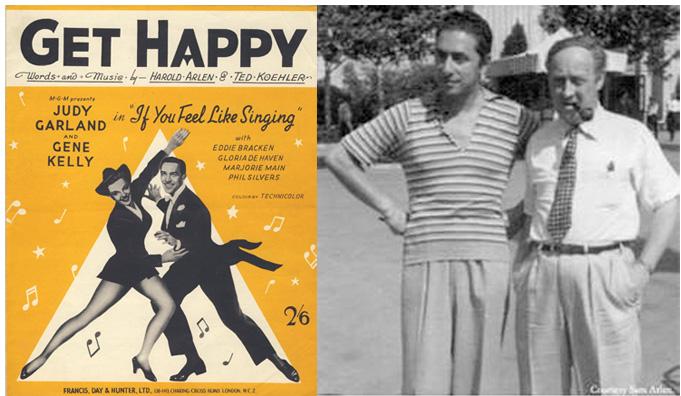

Harold Arlen, Ted Koehler
“Get Happy” was their first hit. Pack up your troubles and just get happy/Ya better chase all your cares away/Sing Hallelujah, c’mon get happy/Get ready for the judgment day… We hear a recording by Nat Shilkret & The Victor Orchestra.”You can still hear the syncopation, but it’s mainstreamed and commercialized to its core,” Rosen notes of the dense iteration. “This is much more the way we think of the song,” introduces an Ella Fitzgerald version. It’s jazzy and clean.
The team’s second success was “Between the Devil and The Deep Blue Sea.” Rosen’s eclectic, favorite rendition is by- wait for it- George Harrison on an album called Brainwashed. Harrison plays the ukulele and sings. It’s wonderful. “George was ukulele crazy. He used to carry several in his trunk to give away…Born in 1943, this was the sound he grew up with.”
A big break for the collaborators came in the early 1930s with opportunity to write for the afterhours Cotton Club. (An iconic Harlem club where, without exception, performers were all black, the audience all white. Shows ran at midnight and 2am.) Duke Ellington’s band was in residence. “I’ve Got the World on a String.” came out of a Cotton Club revue. “Arlen’s approach to singing his own songs is that of a jazz singer, a lot less faithful to melody.” We listen to his all-over-the-place, undulating octave changes.
Introduced by Ethel Waters, “Stormy Weather” also rose from a club revue. Our host points out that “despite the fact it was written by two white men, it spoke to her…People think this is a blues. It’s not. In fact, Arlen only wrote one true blues song- in blues form. He was known as a blues writer because his work goes below the surface…It’s a song not quite as embedded in the culture as “Old Man River,” but close.”
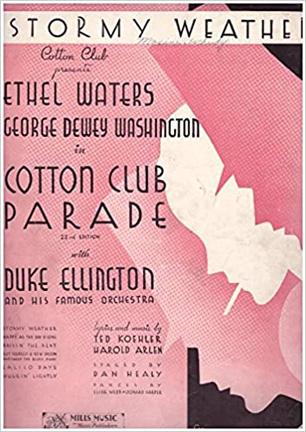

Gershwin, with whom he was friendly, told Arlen he’d spent an hour trying to rewrite the song in hopes of making it more interesting. He thought there should be some repetition and that the bridge was too ordinary. The icon gave up admitting its simplicity was its virtue. We hear the author’s interpretation. Arlen, like many talented song writers, offers insight into the way he heard it when writing. That he’s not always on key seems secondary to us, but his recordings did not sell well.
At this point Arlen started to shuttle back and forth to California. One day in a publisher’s office, he saw a telegram requesting a song called “Let’s Fall in Love.” He promptly sequestered himself in the only place he could be private, the men’s room, and wrote the theme of the song. It was his next hit. The composer often wrote on the fly, carrying a pad and pen for “jottings.”
In 1933, he started writing with E.Y. “Yip” Harburg. “Harburg had gone into business as a young man- because that was the thing to do, but then came the crash. His friend George Gershwin, by then very successful, stakes him to a year of living expenses to give him a chance to break into the business.”
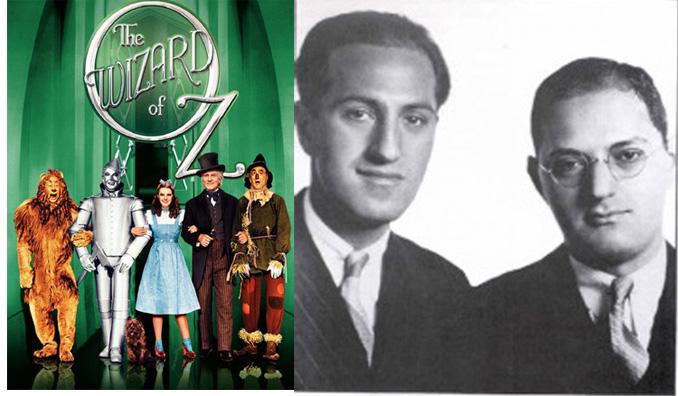

Harold Arlen, Yip Harburg
Arlen’s new lyricist was very political. The year before they came together, Harburg had written the poster song of the Depression, “Brother Can You Spare a Dime.” “If you think you see a socialist agenda in The Wizard of Oz, you’re right,” Rosen says. Reflect on that. Their first well received tune was “It’s Only a Paper Moon.” (Arlen sings)
“In the mid 1930s, he also wrote a couple of songs that show a broader side to his style, more art than pop. Listen to the subtlety with which he plays.” The song is “Ill Wind.” Roiled, rumbling chords support a longlined tenor. Gershwin said, “Harold, people don’t want to hear songs like that.” It became a huge hit. Another of this ilk was “Last Night When We Were Young.” Rosen plays piano and sings a bit. “Can you hear the richness of the harmony?” Sinatra performs like lifting and laying out a soft blanket.
In 1939, the pair were hired by Arthur Freed to write The Wizard of Oz. “Arlen and Harburg referred to them as their gumdrop songs, but blue notes are hidden. (He demonstrates) Perhaps the most famous song in the 20th century, “Somewhere Over the Rainbow” was cut by studio executives and restored three times. Freed went to the mat for it. It won the Academy Award and will likely be around when all of us are long gone. During the period, he and Harburg wrote “Lydia the Tattooed Lady” for Groucho Marx and “Happiness is a Thing Called Joe” for Ethel Waters. “The Man That Got Away” with Ira Gershwin would come later.
The composer then collaborated with Johnny Mercer, whose popular song faculty with southern vernacular rivaled Hoagy Carmichael. The two wrote Arlen’s only actual blues.
“Blues in The Night.” My mama done tol’ me,/ When I was in knee pants,/ My mama done tol’ me, Son!…Rosen points out the construction.
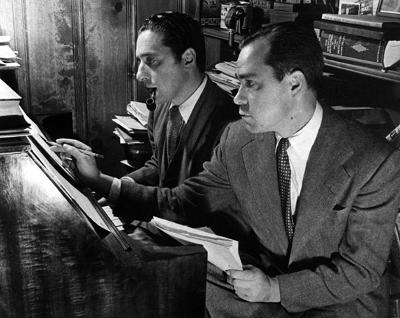

Harold Arlen, Johnny Mercer
“Hit the Road to Dreamland” was created for Star Spangled Rhythm, an all-star movie made to boost morale during WWII. “Even for a lullaby, it had a bluesy feel.” Rosen plays a version, pointing out inner rhymes. “Here’s folk poetry wise in its simplicity.” Next came “Accentuate the Positive,” to which the host bops along on camera.
“Arlen broke out of conventional form to write what he called tapeworms that go on longer while never exactly repeating. “Old Black Magic” is an example.” We hear a long version. Mercer was having a torrid affair with young Judy Garland who seems to have inspired a particularly fertile period of love songs.
In the early 1950s, Arlen moved back to New York. He’d had only a single Broadway success with Bloomer Girl in 1943. (lyrics were Harburg) “In some ways he was a more natural songwriter than overtly theatrical.” Set in Jamaica, House of Flowers had lyrics and book by Truman Capote based on his story, Lyrics and music by Arlen, and was directed by Peter Brook. It concerned two competitive bordellos.
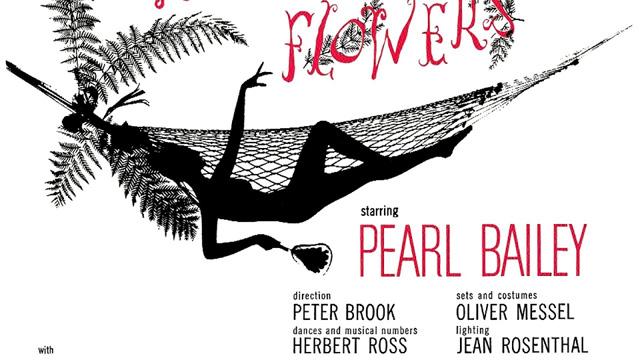

“A Sleepin’ Bee” is the only song with which you might be familiar. Rosen chooses to play us “I Never Has Seen Snow.” “You can hear the intensely soulful, bluesy sound and how close we are to Motown,” he comments. Later Jamaica and Saratoga unsuccessfully followed.
“Popular music was still very much the realm of the young… Elvis Presley, Motown, the Phil Spector sound, songs from The Brill Building…Da doo run run doesn’t compare lyrically to what we’ve been playing. It was hard for songwriters who emerged in the 20s to continue to be part of the current in the 60s. Arlen’s wife, who’d been in and out of mental institutions, was now diagnosed with a brain tumor. He turned more and more inward.
When the composer was asked, What is a songwriter thinking about when he’s not writing songs?” He responded, “Why am I not writing songs?” Many don’t know Arlen by name because he never cultivated a public persona, but his songs live on.
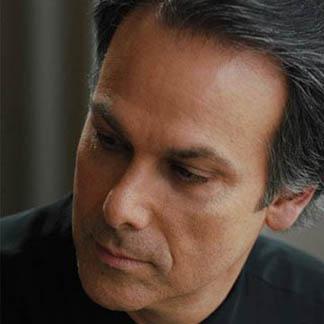

Louis Rosen
“I hope you have a better sense of Arlen than when you entered this virtual universe.”
We do.
Coming Up: Two events on Aaron Copeland, one on Stephen Sondheim’s Passion.

















